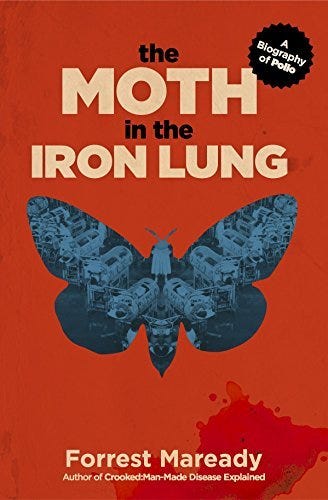Welcome to Polymathic Being, a place to explore counterintuitive insights across multiple domains. These essays explore common topics from different perspectives and disciplines to uncover unique insights and solutions.
Today's topic applies the Polymathic mantra of Learn, Unlearn, and Relearn to the wicked problem of Polio. We start by defining the multiple types of polio, exploring the multiple attack vectors, the multiple confounding considerations, and the multiple incentives to understand better how we’ve come up with such a singular and simple story about this disease.

How did an endemic and omnipresent enterovirus that has existed in our gut for thousands of years suddenly explode in virality, breach the heavily fortified intestinal defenses, and attack a very specific spinal cord region, only to virtually disappear overnight? The story we are told is a wonder of modern medicine: the polio vaccine. The real story is much more cross-disciplinary and convoluted, with multivariate causality and significant cascading consequences. It’s a perfect Polymathic problem, so let’s dive in.
Multiple Polios
We need to start with the definition of Polio because this simple word refers to two different things, and one is named after the other:
Poliomyelitis: The word polio comes from the Greek word polio, meaning “gray.” The word “myelitis” means spinal cord or bone marrow inflammation. Thus, the word poliomyelitis historically meant inflammation of the spinal cord (gray matter) from an unknown variety of sources.
Poliovirus: An endemic enterovirus that can cause poliomyelitis, though it is asymptomatic 95% of the time. (Other enteroviruses causing poliomyelitis include coxsackievirus, echovirus, and D68.)
This is a crucial difference because, for over 100 years, polio was not associated with a specific virus. It was known as Infantile Paralysis or Teething Paralysis as it normally affected teething toddlers with lower extremity paralysis. When they were able to do autopsies, they found lesions in the lower, anterior (front) of the spinal cord gray matter. Hence, gray inflammation. Literally, Poliomyelitis.
Another aspect to consider is that our understanding of human physiology and medicine was still incredibly limited in the late 1800s when infantile paralysis was being recorded. There were no electron microscopes, autopsies were rare and basic, virology and epidemiology were nascent, and they had access to none of the technologies that we have today to pinpoint disease.
It’s no insult to say doctors guessed a lot, and there was no way to differentiate poliomyelitis symptoms from poliovirus or any other neurological attack vector. They were all called Polio. Only recently has poliomyelitis been associated solely with the poliovirus, and subsequently, all other attack vectors causing gray matter inflammation are now bucketed under Nonpolio Acute Flaccid Paralysis. (More on that later)
Multiple Attack Vectors
While the use of Mercury, Arsenic, and Lead sounds like the makings of a whodunit murder novel, these were actually the foundation of the most popular medicines in the 1800s and early 1900s. Yes, medicine. One of the more popular was Steedman's Teething Powder, which contained the innocuous sounding ingredient Calomel, which some might recognize as mercury chloride, a neurotoxin. It was part of a battery of common medicines doctors would throw at everything under the idea that cleansing the gut cured most ills. What are the symptoms of heavy metal poisoning?
Lack of coordination of movements;
Impairment of speech, hearing, walking, and/or
Muscle weakness and paralysis.
Suffice it to say, if you didn’t have polio symptoms before seeing the doctor, you’d likely have them after seeing the doctor. Other issues to add to the pile were mass elective tonsillectomies, which correlated with a surge in the more dangerous bulbar polio. There were also poliomyelitis connections with the introduction of new hypodermic needles, with limited disinfection, plunging pathogens, like the enteroviruses, into the nervous tissues. The result was that poliomyelitis symptoms had multiple attack vectors from within the medical community.
Multiple Confounding Considerations
Thus far, we have multiple diseases under the umbrella of poliomyelitis and multiple attack vectors within medicine. Now, we need to add a layer of multiple confounding considerations. For example, arsenic was also a very common medicine and a key ingredient in pesticides that were introduced during the time poliomyelitis cases were growing. It started with Paris Green being dusted on crops, but chemists quickly found that combining arsenic with lead made the resulting lead arsenate fabulously sticky and resistant to washing off summer crops like fresh fruits and berries. Recall the symptoms of heavy metal poisoning, that poliomyelitis cases were typically clustered in the summer, and you can see the confounding variables.
This is where Forrest Maready's book The Moth in the Iron Lung: A Biography of Polio1 takes center stage.2 He approaches the common story of polio from a very polymathic perspective, teasing apart the definition, investigating the symptoms of rare and isolated outbreaks, and tracing the explosion of polio in the late 1940s and its nearly overnight elimination.
Maready meticulously documents that Polio outbreaks were largely regional and rural until the end of WWII. Polio was also not broadly international; it was heavily clustered in nations, such as Sweden (inventor of Paris Green), that also used lead arsenate-type pesticides. That is, until a new toxic chemical entered the mix: DDT.
DDT (dichlorodiphenyltrichloroethane) is a synthetic chemical liberally used as a pesticide from the 1940s through the 1970s. When I say liberally, I mean it was sprayed everywhere, on everything, and marketed as completely safe. It’s easy to look back today and marvel at the ignorance, but DDT and other heavy metal pesticides are now banned for a reason. Outside of general neurological issues, they also provide a perfect vector for the innocuous poliovirus to break out of the gut defenses and attack the nervous system.3 But what were the incentives to overlook all this?



Multiple Incentives
The first question we need to address in incentives is why so many doctors, researchers, and public health officials defended the use of heavy metals in pesticides and medicines for as long as they did. This is where Hanlon’s Razor makes a necessary cut: “Never attribute to malice that which is adequately explained by stupidity.”
We’ve explored this topic in both The Successfully Unsuccessful and Functional Stupidity. Simply put, there are hundreds of incentives outside of human health and well-being that drive decisions.4
Additionally, as more attention was focused on Polio, numerous philanthropic organizations dedicated vast sums of money to ensure anyone with polio was taken care of. As such, there was a significant push to claim more cases of polio in the late ‘40s and early ‘50s. There were also reciprocal incentives evidenced by an increase in sensationalistic news stories and the advertising of elected officials and donors that they were doing something with their investments. For example, this classic image of the iron lung is actually a staged marketing photo, not a reality of polio at the time:
A Singular Focus
The fact that the poliovirus came out as the singular answer to poliomyelitis is surprising to me because science loves easy and constrained definitions of problems. When researchers were trying to figure out what was causing gray matter inflammation, they followed German bacteriologist Robert Koch’s four postulates:
The microorganism must be present in all individuals with the disease but not in healthy individuals
It must be isolated from a patient and grown in a lab
It must cause the disease when introduced into a healthy individual
The microorganism must be re-isolated from the newly infected individual and matched to the original microorganism
At first blush, this seems like a pretty easy way to narrow down and identify the root cause of polio. However, as we’ve identified, poliomyelitis has multiple symptoms, attack vectors, confounding variables, and incentives. Thus, we have an interconnected, interdisciplinary, and multidimensional problem with cascading consequences and not something that distills down into a simple, singular answer.
So, Where Did Polio Go?
After approximately the 1960s, science was now able to measure the presence of the poliovirus, and the term polio was subsumed completely as having to do with the virus. Polio went from being a family of afflictions to a singular virus.
It’s also important to recognize those additional variables. The release of the nascent vaccine coincided with a significant reduction and even banning of heavy metal medicines and pesticides, not to mention significant increases in sanitation, improved medical treatment, and more.
Moreover, they also changed how they measured a polio case from requiring a patient to exhibit symptoms for only 24 hrs to requiring 60 days of symptoms to be counted as polio after the vaccine was released. This simple measurement change erased thousands of cases overnight.5 Futher, with refined measurements, anything with poliomyelitis symptoms but without the presence of poliovirus is not considered polio.
We removed heavy metal toxins, redefined poliomyelitis, changed the diagnosis requirements, and more, all of which make understanding the problem difficult. It also raises an obvious question: Is there still gray spinal matter inflammation that leads to paralysis?
Absolutely. We call it Nonpolio Acute Flaccid Paralysis (nonpolio AFP), and it still exists in large numbers in countries like India, which continue to use heavy metal and DDT-type pesticides. Compounding this, India has incentives to push any gray spinal matter inflammation into the nonpolio AFP category, as the penultimate paragraph in the book, The Moth in the Iron Lung, captures so well:
“Whatever the specific cause, it is clear that when children’s intestinal health is severely comprimised, paralysis will follow. Polio[virus] rates may have gone down in India, but poliomyelitis certainly has not. The crippling paralysis caused by various assults on the central nvervous system will continue to be a problem as long as the gut health of the country’s children is decimated by constant pesticide exposure.”
Polio[virus] is gone, but poliomyelitis still exists because it may never have been about a virus. Instead, the disease that terrified America6 is more likely a general class of symptoms caused by multi-variate conditions largely clustered around heavy metal and industrial chemical toxicity and still remains a threat. The vaccine helped with the virus but it did not help poliomyelitis. We handled that by removing heavy metal toxins with pesticide, medicine regulations, and changing the diagnostic criteria.
Summary
So, what’s the point of the investigation?7 It’s the decomposition of what we’ve been told as a simple story into the true complexity of the situation. It’s an opportunity to look back with a Systems Thinking mindset and a Polymathic approach, look at it from multiple perspectives, and embrace the complexity while challenging the simple answer. In doing so, we can find patterns and insights that we can apply in the future.
The knee-jerk reaction to ‘trust the experts’ becomes glaringly ignorant when, 100 years ago, many experts were prescribing mercury-laden drugs, defending lead arsenate on fresh produce, and hyper-focused on a single cause for a family of symptoms, all while being driven by multiple incentives. It truly is a wicked problem of virology, toxicology, epidemiology, psychology, sociology, political science, and more. I want medicine to work; I want science to be better.
The bottom line is that it’s a beautiful example of why we need more aspiring Polymaths who embrace insatiable curiosity, the humility to accept that we don’t know everything, and the intentional reframing of the problem to see if the definition changes. Polio provides a wonderful opportunity to Learn, Unlearn, and Relearn.8
Did you enjoy this post? If so, please hit the ❤️ button above or below. This will help more people discover Substacks like this one, which is great. Also, please share here or in your network to help us grow.
Polymathic Being is a reader-supported publication. Becoming a paid member keeps these essays open for everyone. Hurry and grab 20% off an annual subscription. That’s $24 a year or $2 a month. It’s just 50¢ an essay and makes a big difference.
Further Reading from Authors I Appreciate
I highly recommend the following Substacks for their great content and complementary explorations of topics that Polymathic Being shares.
- All-around great daily essays
- Insightful Life Tips and Tricks
- Highly useful insights into using AI for writing
- Integrating AI into education
- Computer Science for Everyone
This essay was motivated by the book, which I found well-written, researched, and sourced. It was also eye-opening, as I’d always accepted the simple explanation of polio. The main criticism I’ve seen is that he’s not a virologist or epidemiologist, which is an appeal to authority logical fallacy. If anything, that critique means they have nothing else.
After writing this, I came across the book by Dr. Suzanne Humphries, “Dissolving Illusions: Disease, Vaccines, and The Forgotten History,” which also documents polio and other diseases and the interesting quandaries regarding vaccines.
Let’s not forget how Agent Orange was used in Vietnam to cause horrific neurological damage to those we sent to fight.
I’ve run out of space to even talk about the Moth in the title of the book, but I’ll leave that to the curious reader to explore as another incentive driven by human stupidity.
This article refers to this change as a myth that the vaccine didn’t work but confirms that the diganostic methods were changed and that did reduce cases. They’re point was that it was nessesary to diagnose the cases caused by the virus vs. other poliomyelitis cases which ends up confiming the compounding considerations sections.
https://vaxopedia.org/2018/07/25/the-myth-that-polio-only-went-away-because-they-changed-the-way-it-was-diagnosed/
Never underestimate how terrified America was. During the NYC outbreak, they estimate more children died from parental reactions to Polio than would have died from Polio. The national panic, the constant drumbeat of fear, the loud reporting of any cases, and the public advertising and extreme demands of quarantine imprinted Polio as a mind virus into the psyche of the Boomer generation.
The uncharitable will likely accuse me of being anti-vax; some may, ironically, claim this is anti-science. Both are ignorantly wrong. I want vaccines to work; I want science to be better.
If you see the parallels between this investigation of Polio and our national experience with COVID, you’d be right over the target of why this is so important.










I binge-read Robert Anton Wilson's Cosmic Trigger series recently, and he had childhood polio ... he was healed by the Kenny Method, which was considered "pseudoscience" at the time.
As one of the many kids who got the first version of the Salk vaccine -- the one that was not foolproof and resulted in some new polio cases -- I consider myself very lucky. Very lucky to have not been one of those unfortunate kids who got a milder version of polio, but to be one of the first kids in the world to be pretty much assured of not acquiring the scourge of one of the most heinous diseases known to man. Although I was only four years old in the early '50s (my mom lied to get me in...you had to be five yo), it was the only time in my life I saw both of my parents cry.
Idiotic Americans who won't get their kids vaccinated because of their faulty, unscientific and uncritical thinking of what vaccines can do are now the scourge of America. Not only are they sentencing their kids to diseases that have been supposedly eradicated, they are enabling other children to catch these diseases as well.
Just like the Middle Ages population of Europe seemingly forgot everything the Greeks and Romans and other learned societies had gleaned centuries before (it was more like the Church denying knowledge to the masses to keep the public under their control), so too are we moving backward in time as real time unerringly moves forward.
Hey everybody -- you are on your own. Don't believe anyone until you critically think through the problems and do your own research. However, this doesn't apply to vaccinations -- you don't have the blessing of time to make up your mind. And, if I run into anyone who has decided not to vaccinate their kids, please expect a gut-check. Not figuratively, but actually.